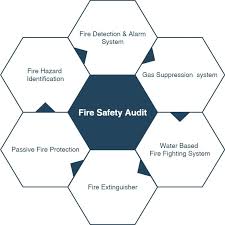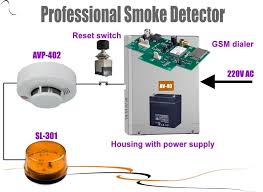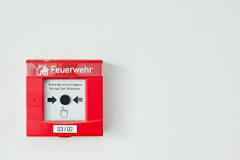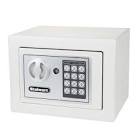Fire Audit: Ensuring Safety and Compliance
A fire audit is a comprehensive examination of a building or premises to assess its fire safety measures and ensure compliance with local regulations and standards. Conducted by qualified professionals, a fire audit plays a crucial role in identifying potential fire hazards, evaluating existing fire protection systems, and recommending necessary improvements to enhance the overall level of fire safety.
During a fire audit, various aspects related to fire safety are thoroughly inspected, including but not limited to:
- Presence and functionality of fire detection and alarm systems
- Adequacy of firefighting equipment such as extinguishers, hydrants, hoses, etc.
- Maintenance of emergency lighting and exit signs for safe evacuation
- Condition of electrical systems to prevent short circuits and electrical fires
- Proper storage and handling of flammable materials
- Compliance with building codes and regulations related to fire safety
The primary objectives of a fire audit are to:
- Identify potential fire hazards and risks within the premises
- Evaluate the effectiveness of existing fire protection measures
- Ensure compliance with legal requirements and standards for fire safety
- Recommend corrective actions and improvements to mitigate risks and enhance safety levels
- Create an emergency response plan in case of a fire incident
By conducting regular fire audits, organizations can proactively address any deficiencies in their fire safety measures, reduce the likelihood of fires breaking out, minimize property damage, protect lives, and maintain business continuity. It is essential for businesses, educational institutions, healthcare facilities, residential complexes, industrial units, and other establishments to prioritize fire safety through regular audits and compliance with recommended guidelines.
In conclusion, a thorough fire audit is a critical step towards ensuring the safety of occupants within a building or premises. By investing in proactive measures to prevent fires and respond effectively in case of emergencies, organizations can create a secure environment that prioritizes the well-being of individuals while also safeguarding property against potential risks posed by fires.
9 Essential Tips for Conducting an Effective Fire Safety Audit
- Ensure all fire alarms are in working condition.
- Regularly inspect and maintain fire extinguishers.
- Keep emergency exits clear and unobstructed.
- Train employees on fire safety procedures and evacuation plans.
- Conduct regular fire drills to practice emergency response.
- Check electrical systems for any potential fire hazards.
- Store flammable materials safely and according to regulations.
- Install smoke detectors in key areas of the building.
- Review and update your fire safety plan regularly.
Ensure all fire alarms are in working condition.
It is crucial to ensure that all fire alarms are in working condition to maintain a high level of fire safety within a building or premises. Functional fire alarms play a vital role in alerting occupants in the event of a fire, allowing for timely evacuation and swift response from firefighting personnel. Regular testing and maintenance of fire alarm systems are essential to ensure their reliability and effectiveness during emergencies. By prioritizing the upkeep of fire alarms, organizations can enhance their overall preparedness to mitigate the risks associated with fires and safeguard lives and property.
Regularly inspect and maintain fire extinguishers.
Regularly inspecting and maintaining fire extinguishers is a crucial aspect of fire safety practices in any building or premises. Fire extinguishers are essential tools for quickly containing and extinguishing small fires before they escalate into larger, more dangerous incidents. By conducting routine inspections to ensure that fire extinguishers are in proper working condition, have not expired, and are easily accessible, individuals can enhance the effectiveness of their fire protection measures. Additionally, regular maintenance tasks such as checking pressure levels, inspecting for damage or signs of wear, and scheduling professional servicing when needed can help ensure that fire extinguishers remain reliable and ready for use in the event of a fire emergency.
Keep emergency exits clear and unobstructed.
One crucial tip to remember during a fire audit is to keep emergency exits clear and unobstructed at all times. In the event of a fire emergency, easy and unimpeded access to designated exit points can make a significant difference in ensuring a swift and safe evacuation for occupants. By maintaining clear pathways free from obstacles or clutter, businesses and organizations can enhance the effectiveness of their emergency evacuation procedures and minimize the risk of injuries or delays during critical moments. Regularly inspecting and enforcing the importance of keeping emergency exits unobstructed is essential for maintaining optimal fire safety standards within any premises.
Train employees on fire safety procedures and evacuation plans.
Training employees on fire safety procedures and evacuation plans is a crucial aspect of ensuring preparedness and effective response in the event of a fire emergency. By educating staff members on how to identify fire hazards, operate firefighting equipment, raise alarms, and evacuate safely, organizations empower their workforce to take proactive measures to prevent fires and respond swiftly in case of an incident. Regular training sessions also help reinforce the importance of fire safety protocols, instill a culture of vigilance and readiness among employees, and contribute to creating a safer work environment for everyone.
Conduct regular fire drills to practice emergency response.
One crucial tip for a successful fire audit is to conduct regular fire drills to practice emergency response procedures. Fire drills play a vital role in familiarizing occupants with evacuation routes, emergency exits, and proper response protocols in the event of a fire. By simulating fire scenarios through drills, individuals can gain valuable experience in reacting swiftly and calmly during emergencies, ultimately enhancing overall preparedness and safety levels within the premises. Regular practice ensures that everyone knows their roles and responsibilities, helping to minimize confusion and maximize efficiency during real-life fire incidents.
Check electrical systems for any potential fire hazards.
It is crucial to check electrical systems for any potential fire hazards during a fire audit. Faulty wiring, overloaded circuits, damaged outlets, and outdated electrical equipment can increase the risk of electrical fires. By ensuring that electrical systems are properly maintained, inspected regularly, and compliant with safety standards, organizations can significantly reduce the likelihood of fire incidents caused by electrical faults. Conducting thorough inspections and addressing any identified issues promptly can help enhance overall fire safety within a building or premises.
Store flammable materials safely and according to regulations.
It is crucial to store flammable materials safely and in accordance with regulations as part of a fire audit. Improper storage of flammable substances can significantly increase the risk of fire incidents within a premises. By following guidelines and regulations for the storage of flammable materials, such as maintaining proper ventilation, using appropriate containers, and ensuring adequate separation from potential ignition sources, organizations can mitigate the risk of fires and enhance overall fire safety measures. Proper storage practices not only reduce the likelihood of accidents but also demonstrate a commitment to maintaining a safe environment for occupants and protecting property from potential harm.
Install smoke detectors in key areas of the building.
Installing smoke detectors in key areas of the building is a crucial step in enhancing fire safety and early detection of potential fire incidents. Smoke detectors serve as vital tools in alerting occupants to the presence of smoke, a common indicator of fire, allowing for prompt evacuation and timely intervention to prevent the spread of flames. By strategically placing smoke detectors in key areas such as hallways, bedrooms, kitchens, and other high-risk zones, organizations can significantly improve their ability to detect fires at an early stage and mitigate potential risks effectively. Regular maintenance and testing of smoke detectors are essential to ensure their proper functioning and reliability in providing early warnings that can save lives and property in the event of a fire emergency.
Review and update your fire safety plan regularly.
Reviewing and updating your fire safety plan regularly is a crucial tip to ensure the effectiveness of your fire audit. By regularly revisiting and revising your fire safety plan, you can incorporate any changes in regulations, building layout, occupancy, or operations that may impact fire safety measures. This proactive approach helps to identify and address potential gaps or weaknesses in your existing plan, ensuring that it remains relevant and comprehensive in mitigating fire risks and promoting a safe environment for occupants. Regular updates also enable you to refine emergency procedures, train personnel on new protocols, and stay prepared to respond effectively in the event of a fire emergency.




